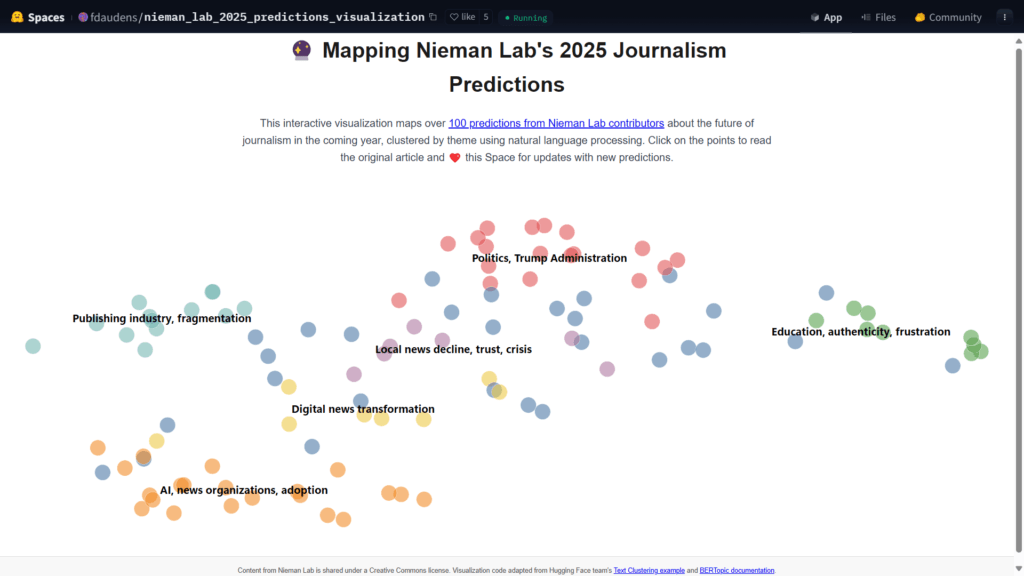The Seven Forces Driving Journalism’s Evolution in 2025

As we step into 2025, the journalism landscape is undergoing a profound transformation, fueled by rapid technological innovation, shifting audience habits, and the ever-changing demands of society. These shifts are not just speculative, they are already unfolding, as highlighted by industry experts in Nieman Lab’s annual predictions for journalism.
Each year, Nieman Lab gathers insights from some of the brightest minds in media to forecast the trends and challenges shaping the future of news. This year’s predictions paint a vivid picture of a field in flux, where artificial intelligence, evolving consumption patterns, and the quest for trust and sustainability are redefining what journalism means in the digital age. In this article, we explore seven key trends driving this transformation, drawing on the most compelling insights from Nieman Lab’s 2025 predictions. From the rise of AI to the resurgence of local news, these trends offer a roadmap for understanding where journalism is headed, and how it might navigate the challenges ahead.
1. The Rise of AI in Journalism: A Double-Edged Sword
AI is set to revolutionize journalism, but its impact will be a double-edged sword. On one hand, AI will automate content creation, personalize news delivery, and enhance data analysis, making journalism more efficient and accessible. For instance, AI-driven tools will help in translating content into multiple languages, making multilingual news accessible to a broader audience (Benjamin Morales Meléndez). However, the proliferation of AI-generated content could also lead to a decline in trust, as audiences struggle to distinguish between human and machine-generated content (S. Mitra Kalita).
2. The Shift in News Consumption: Podcasts, Prediction Markets, and Informal Networks
The way news is consumed is evolving, with podcasts, prediction markets, and informal news networks gaining traction. Small and mid-level podcasts are expected to thrive, as super listeners seek deeper connections with their favorite shows (Juleyka Lantigua). Meanwhile, prediction markets could become a mainstream source of information, challenging the relevance of traditional media (Taylor Lorenz). Informal news networks, which prioritize reliable information over traditional news structures, will also rise, offering new avenues for public engagement (Heather Chaplin).
3. The Decline of Traditional Media: Adapting to a Fragmented Landscape
Traditional media faces a existential crisis as it grapples with declining relevance. The barbell strategy, which focuses on producing either very short or very long content, is expected to replace middling stories (Millie Tran). Additionally, the rise of influencer journalism and the blurring lines between news and activism could further erode the credibility of legacy media (Aimee Rinehart). In response, media companies must adapt by becoming “bundlers” that aggregate content from diverse sources, or risk being overtaken by tech platforms (Ben Smith).

4. Trust and Transparency: The New Currency in Journalism
In a world saturated with information, trust and transparency will be the new currency in journalism. As AI-generated content becomes more prevalent, journalists must be transparent about their methods and sources to maintain credibility (Nik Usher). Furthermore, the rise of dark patterns in news design, which manipulate user behavior, will force news organizations to reevaluate their ethical standards (Jasmine McNealy). The media must also confront its role in the “moral injury epidemic,” where journalists are increasingly exposed to trauma and burnout, necessitating a shift towards more humane and empathetic reporting practices (Carrie Brown).
5. Collaboration and Community: Building Resilience Through Partnerships
Collaboration and community building will be crucial in the future of journalism. Cross-border collaborations will shine light in “dark corners” of the world, countering illiberal regimes’ efforts to suppress information (Laxmi Parthasarathy). Additionally, local newsrooms will see a resurgence as they focus on building relationships with their communities, offering personalized and relevant content (Fran Wills). Journalists will also need to embrace transparency about the business side of media, acknowledging the financial realities that shape their work (Jacob L. Nelson).
6. Redefining Sustainability: New Models for Funding and Support
Sustainability in journalism will require rethinking traditional funding models. Philanthropy, state and local initiatives, and innovative business plans will play increasingly important roles in supporting independent journalism (Nancy Watzman). Additionally, newsrooms will need to focus on the “flabby middle” of the audience funnel, offering trial periods and engaging experiences to attract and retain readers (Sarah Marshall).
7. The Urgency of Evolution: Journalism’s Responsibility in a Changing World
In 2025, the urgency of evolution is clear. Journalism must adapt to meet the demands of a changing society, embracing new technologies, redefining its role in the public sphere, and prioritizing the needs of its audience. The predictions from industry professionals highlight a future where journalism is more personalized, collaborative, and community-driven, but also more vulnerable to disinformation and technological disruption.
In conclusion, 2025 will be a year of transformation for journalism, marked by the rise of AI, shifting consumption patterns, and the need for greater transparency and collaboration. As the industry navigates these changes, it must remain committed to its core principles of truth, accuracy, and public service, while embracing the innovative tools and strategies that will shape the future of news.







